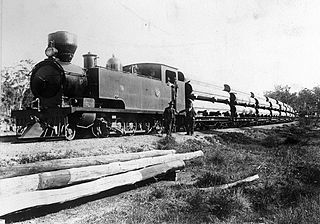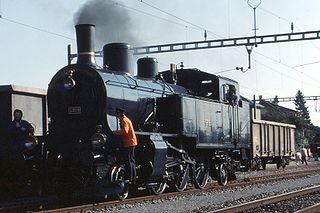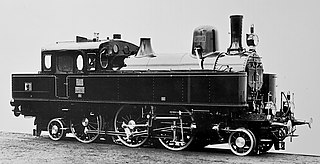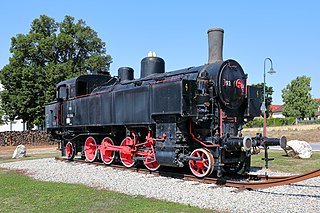A geared steam locomotive is a type of steam locomotive which uses gearing, usually reduction gearing, in the drivetrain, as opposed to the common directly driven design.

Under the Whyte notation, a 2-8-4 is a steam locomotive that has two unpowered leading wheels, followed by eight coupled and powered driving wheels, and four trailing wheels. This locomotive type is most often referred to as a Berkshire, though the Chesapeake and Ohio Railway used the name Kanawha for their 2-8-4s. In Europe, this wheel arrangement was mostly seen in mainline passenger express locomotives and, in certain countries, in tank locomotives.
Under the Whyte notation for the classification of steam locomotives, 0-8-0 represents the wheel arrangement of no leading wheels, eight powered and coupled driving wheels on four axles and no trailing wheels. Locomotives of this type are also referred to as eight coupled.

Under the Whyte notation for the classification of steam locomotives, 0-4-2 represents the wheel arrangement with no leading wheels, four powered and coupled driving wheels on two axles and two trailing wheels on one axle. While the first locomotives of this wheel arrangement were tender engines, the configuration was later often used for tank engines, which is noted by adding letter suffixes to the configuration, such as 0-4-2T for a conventional side-tank locomotive, 0-4-2ST for a saddle-tank locomotive, 0-4-2WT for a well-tank locomotive and 0-4-2RT for a rack-equipped tank locomotive. The arrangement is sometimes known as Olomana after a Hawaiian 0-4-2 locomotive of 1883.
Under the Whyte notation for the classification of steam locomotives, 0-12-0 represents the wheel arrangement of no leading wheels, twelve powered and coupled driving wheels on six axles, and no trailing wheels.

The Schneeberg Railway is one of three rack railways in Austria still operating, and runs from the small town of Puchberg am Schneeberg in Lower Austria up to a plateau beneath the Schneeberg summit. At 2,076 metres (6,811 ft), the Schneeberg is the highest mountain in Lower Austria. The other two working cog railways in Austria are the Schafberg Railway and the Achensee Railway.

For more than a century, the Swiss locomotive, multiple unit, motor coach and railcar classification system, in either its original or updated forms, has been used to name and classify the rolling stock operated on the railways of Switzerland. It started out as a uniform system for the classification and naming of all rolling stock, powered and unpowered, but had been replaced and amended by the UIC classification of goods wagons.

The Class PtL 2/2 locomotives of the Royal Bavarian State Railways were light and very compact superheated steam locomotives for operation on Bavarian branch lines. There were three types in total, of which two were transferred to the Deutsche Reichsbahn-Gesellschaft as Class 98.3 tank locomotives and even survived to join the Deutsche Bundesbahn fleet after the Second World War.

The Württemberg Hz were 0-10-0 rack and adhesion steam locomotives, that were initially developed by the Royal Württemberg State Railways, but were delivered to the Deutsche Reichsbahn-Gesellschaft (DRG) in the mid-1920s.

The steam locomotive class kkStB 429 was a class of passenger locomotive operated by the Imperial Royal Austrian State Railways, kkStB.

The kkStB 229 was a class of passenger 2-6-2 tank engines with the Imperial Royal Austrian State Railways, kkStB.

Karl Gölsdorf was an Austrian engineer and locomotive designer.

The South African Railways Class 6Z 2-6-4 of 1901 was a steam locomotive from the pre-Union era in the Cape of Good Hope.

The NZASM 32 Tonner 0-4-2RT of 1894 was a South African steam locomotive from the pre-Union era in Transvaal.

The Central South African Railways Rack 4-6-4RT of 1905 was a South African steam locomotive from the pre-Union era in Transvaal Colony.

The kkStB 97 were a class of 228 0-6-0T locomotive operated by the Imperial Royal Austrian State Railways, or k.k.StB, for duties on secondary routes (Nebenbahnen) and branch lines (Lokalbahnen).

The kkStB 30 were a class of 2-6-2T locomotives designed by Karl Gölsdorf for use of the Vienna Stadtbahn of the Imperial Royal Austrian State Railways. They were specifically designed for use on the inner-city routes of the Vienna Stadtbahn, where they hauled trains of up to ten of the Stadtbahn's 4-wheeled carriages. They were built by Lokomotivfabrik Floridsdorf, Wiener Neustädter Lokomotivfabrik and Lokomotivfabrik der StEG between 1895 and 1901.

The BBÖ 378 was a class of 167 Austrian 2-8-2 tank locomotives built by all four Austrian locomotive manufacturers in the 1920s and 1930s.
















